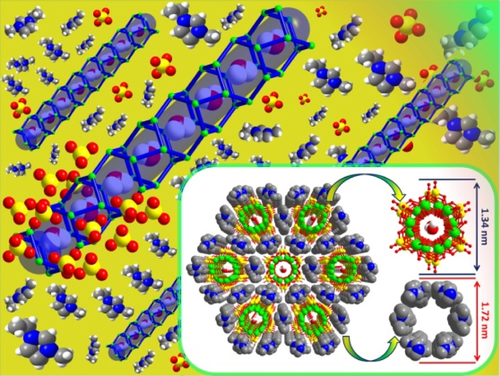Our official English website, www.x-mol.net, welcomes your
feedback! (Note: you will need to create a separate account there.)
Atomically Precise Titanium–Oxo Nanotube with Selective Water Adsorption and Semiconductive Behaviors
CCS Chemistry ( IF 9.4 ) Pub Date : 2020/3/28 , DOI: 10.31635/ccschem.020.202 Kalpana Chintakrinda, Nagaraju Narayanam, Yan-Zhou Li, Fei Wang, Chiranjeevulu Kashi, Qiao-Hong Li, Gang Xu, Lei Zhang*, and Jian Zhang
CCS Chemistry ( IF 9.4 ) Pub Date : 2020/3/28 , DOI: 10.31635/ccschem.020.202 Kalpana Chintakrinda, Nagaraju Narayanam, Yan-Zhou Li, Fei Wang, Chiranjeevulu Kashi, Qiao-Hong Li, Gang Xu, Lei Zhang*, and Jian Zhang

|
We report the first example of carbon nanotube (CNT)-like assembly of the titanium (Ti) framework, Ti oxo inorganic cluster (Ti6O6) hexagonal rings into a titanium oxide (Ti–O) nanotube, prepared by ionothermal synthesis. As determined by single-crystal X-ray diffraction analysis, the Ti–O nanotube arrays, stabilized by sulfate ligands, assumed proper parallel alignment with each other and were separated by supramolecular interactions with surrounding EMIm (1-Ethyl-3-methylimidazolium) counter cations. Our stability studies indicated that the Ti–O nanotube obtained is indeed stable in air and various solvents. Also, it could maintain its structure upon heating to ~300 °C. Moreover, inside the pores of the Ti–O nanotubes, a rare water molecules nanoconfinement behavior was observed at room temperature. Further, our current developed Ti–O nanotube arrays exhibited selective water adsorption over methanol and ethanol, showing potential applications for miscible solvents separations. Finally, these Ti–O nanotubes demonstrated typical semiconductive characteristics, with the electrical conductivity increasing four orders of magnitude, ranging from 3.15?×?10?10–1.03?×?10?6 S/cm, as the temperature increased from 35 to 135 °C. This work represents a milestone in constructing inorganic Ti–O nanotube arrays with atomically precise structural information for applications as visible-light-induced photocatalysts, semiconductors, sensors, and optoelectronics.
中文翻译:

具有选择性水吸附和半导体行为的原子精确钛-氧纳米管
我们报告了钛(Ti)骨架的类似碳纳米管(CNT)组装的第一个例子,通过离子热合成制备的钛氧代无机簇(Ti6O6)六角环成氧化钛(Ti–O)纳米管。通过单晶X射线衍射分析确定,由硫酸盐配体稳定的Ti–O纳米管阵列假定彼此正确平行排列,并通过与周围EMIm(1-乙基-3-甲基咪唑鎓)的超分子相互作用而分离阳离子。我们的稳定性研究表明,所获得的Ti-O纳米管在空气和各种溶剂中确实稳定。另外,加热至约300°C时仍可保持其结构。此外,在Ti–O纳米管的孔内,在室温下观察到了罕见的水分子纳米约束行为。进一步,我们当前开发的Ti-O纳米管阵列在甲醇和乙醇上表现出选择性的水吸附能力,显示出可混溶溶剂分离的潜在应用。最后,这些Ti–O纳米管表现出典型的半导体特性,随着温度从35℃升高到30℃,导电率增加了四个数量级,范围从3.15?×?10?10–1.03?×?10?6 S / cm。 135℃。这项工作代表了构建具有原子精确结构信息的无机Ti-O纳米管阵列的一个里程碑,可用于可见光诱导的光催化剂,半导体,传感器和光电子学。这些Ti–O纳米管表现出典型的半导体特性,随着温度从35°C升高到135°C,电导率增加了四个数量级,范围从3.15?×?10?10–1.03?×?10?6 S / cm。 C。这项工作代表了构建具有原子精确结构信息的无机Ti–O纳米管阵列的里程碑,可用于可见光诱导的光催化剂,半导体,传感器和光电子学。这些Ti–O纳米管表现出典型的半导体特性,随着温度从35°C升高到135°C,电导率增加了四个数量级,范围从3.15?×?10?10–1.03?×?10?6 S / cm。 C。这项工作代表了构建具有原子精确结构信息的无机Ti-O纳米管阵列的一个里程碑,可用于可见光诱导的光催化剂,半导体,传感器和光电子学。
更新日期:2020-06-24
中文翻译:

具有选择性水吸附和半导体行为的原子精确钛-氧纳米管
我们报告了钛(Ti)骨架的类似碳纳米管(CNT)组装的第一个例子,通过离子热合成制备的钛氧代无机簇(Ti6O6)六角环成氧化钛(Ti–O)纳米管。通过单晶X射线衍射分析确定,由硫酸盐配体稳定的Ti–O纳米管阵列假定彼此正确平行排列,并通过与周围EMIm(1-乙基-3-甲基咪唑鎓)的超分子相互作用而分离阳离子。我们的稳定性研究表明,所获得的Ti-O纳米管在空气和各种溶剂中确实稳定。另外,加热至约300°C时仍可保持其结构。此外,在Ti–O纳米管的孔内,在室温下观察到了罕见的水分子纳米约束行为。进一步,我们当前开发的Ti-O纳米管阵列在甲醇和乙醇上表现出选择性的水吸附能力,显示出可混溶溶剂分离的潜在应用。最后,这些Ti–O纳米管表现出典型的半导体特性,随着温度从35℃升高到30℃,导电率增加了四个数量级,范围从3.15?×?10?10–1.03?×?10?6 S / cm。 135℃。这项工作代表了构建具有原子精确结构信息的无机Ti-O纳米管阵列的一个里程碑,可用于可见光诱导的光催化剂,半导体,传感器和光电子学。这些Ti–O纳米管表现出典型的半导体特性,随着温度从35°C升高到135°C,电导率增加了四个数量级,范围从3.15?×?10?10–1.03?×?10?6 S / cm。 C。这项工作代表了构建具有原子精确结构信息的无机Ti–O纳米管阵列的里程碑,可用于可见光诱导的光催化剂,半导体,传感器和光电子学。这些Ti–O纳米管表现出典型的半导体特性,随着温度从35°C升高到135°C,电导率增加了四个数量级,范围从3.15?×?10?10–1.03?×?10?6 S / cm。 C。这项工作代表了构建具有原子精确结构信息的无机Ti-O纳米管阵列的一个里程碑,可用于可见光诱导的光催化剂,半导体,传感器和光电子学。











































 京公网安备 11010802027423号
京公网安备 11010802027423号